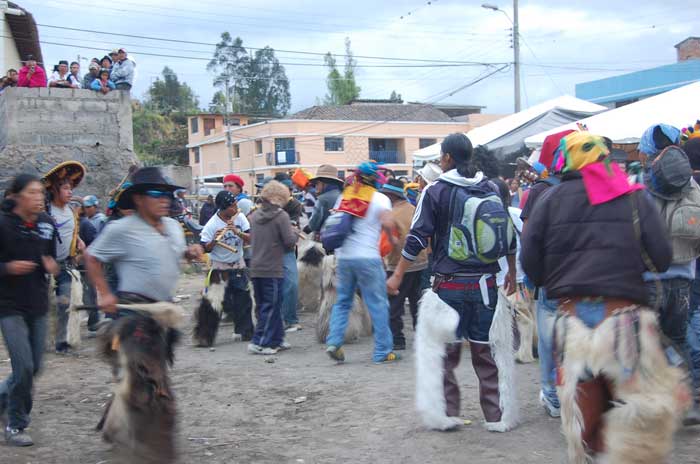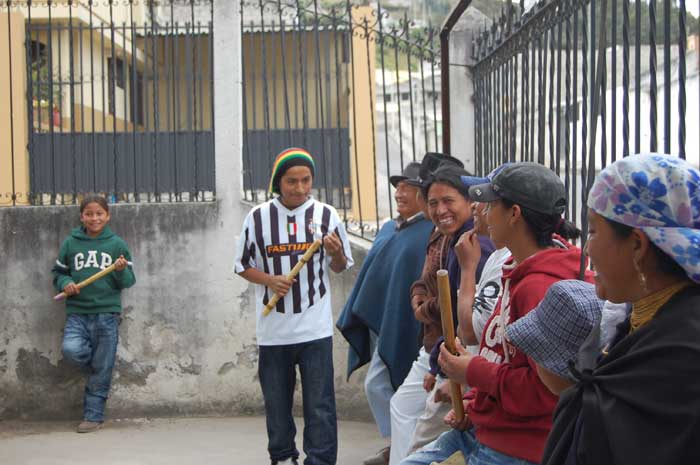¡Kashnami Kawsanchik! This Is How We Live!
Prior to my first trip to Ecuador in 2010, I spent my teenage summers combing through stacks of CDs sold by Otavalan merchants at venues like the Great New York State Fair. When I traveled to Otavalo during the Hatun Puncha-Inti Raymi summer solstice festival, I expected to hear groups of musicians playing sanjuanitos on panpipes (zampoñas, Spanish), notched end-blown flutes (quenas, Sp.), violins, and guitars. Upon my arrival at the Maldonado household, however, I was introduced to transverse cane flutes (called flautas or gaitas, Sp.), which sounded nothing like what I had listened to on my recordings of well-known Otavalan groups like Runakuna, Sisa Pacari, or Ñanda Mañachi. When I asked Patricio Maldonado (one of my host brothers and manager of Hatun Kotama) about the flutes, he modestly told me, “It’s just a little tradition we have here.”
The music that Hatun Kotama will perform during the 2013 Smithsonian Folklife Festival is – for the most part – ritualistic and played by men. Throughout Hatun Puncha-Inti Raymi, musicians perform facing each other, turning in a small, tight circle while dancers form a large spiral around them. The repetitive characteristic of the music places the participants in a trance-like state, allowing for them to connect with each other, spirits, Mother Earth, and our cosmos through song and dance. The songs are in a two-part form and do not have a standard ending or closure to the music because flutists repeat the same tune until the next duo or trio of musicians interrupts with another song.
Flauta music still maintains its own unique tuning system, or musical language, that does not correspond to the Western twelve-tone organization of pitches. Songs, or tunus, are polyphonic, short, and repetitive. To someone not familiar with this music, it may sound melancholic, spooky, or urgent, though to the Runakuna, it is spirited and enlivening. One may also assume that the music is simple because the instruments are rustic in appearance, but as I became more acquainted with this tradition, I began to realize how difficult it is to master even one song. Flute masters’ performance technique includes ornamentations, such as trills and vibrato, and an impeccable embouchure, which creates a strong sound capable of cutting through ambient noise of festival onlookers, dancers, and competing groups of musicians.
By far, one of the most challenging aspects of playing the Otavalan transverse flute is being able to maintain one’s endurance throughout Hatun Puncha-Inti Raymi, performing day and night over a week’s time with little rest. A competent flutist must adhere to strict performance standards and memorize the melodies without error, or else they risk being ejected from the player’s circle.
Hatun Kotama is at the forefront of the flauta grassroots revival movement. Whereas other Otavalan villages have traditionally been known for their flute makers, Kotama has been regarded as a home of outstanding flutists. The founders of Hatun Kotama, several of whom you will meet at this year’s Folklife Festival, recognized that the tradition was disappearing and at risk of becoming obsolete due to religious conversion, migration, economic changes, the adaptation of new instruments, and the 1990s cholera epidemic. They are also aware of the important role flauta music holds in Runa culture. At their cultural center, the flute teachers do not only intend to pass on flauta techniques and repertoire; rather, they hold themselves responsible for transmitting other types of cultural knowledge, such as the Kichwa language (all classes are run completely in Kichwa), and how to live together (convivir, Sp.). Their recording project with Smithsonian Folkways, ¡Así Kotama!: The Flutes of Otavalo, Ecuador, is an example of Hatun Kotama’s mission to preserve their tradition while redefining it in today’s world.
During my field research in Ecuador, one of the phrases I was most often told by the Maldonado family and flute masters was “kashnami kawsanchik,” or “this is how we live!” It has been an honor for me to learn from them, and I look forward to being able to reciprocate by sharing my life and culture with them during their residency at the festival. If you will be in the D.C. area for the second week of the Folklife Festival, stop by the One World, Many Voices: Endangered Languages and Cultural Heritage exhibit to meet the flute players. This week is also a great opportunity for you to convivir by not only observing, but also dancing with the flutists and sharing with them how you live, too.
Hatun Kotama will be in the “tree plot” area of the One World, Many Voices program starting July 3. They perform an evening concert on the Voices of the World Stage on Saturday, July 6, 6:00 p.m.
Click on images to enlarge and view captions. All photos courtesy of Jessie M. Vallejo. <




Jessie M. Vallejo is a Ph.D. candidate at the University of California, Los Angeles. Her dissertation focuses on the Otavalan transverse flute tradition (called flauta or gaita). She began working with flutists from the Hatun Kotama Cultural Center and other nearby Kichwa communities in 2010. Apart from her research activities, Jessie has performed violin with indigenous ensembles and mariachi groups in northern Ecuador. At UCLA, she is co-director of Mariachi de Uclatlán and member of the Chinese Silk and Bamboo ensemble.

